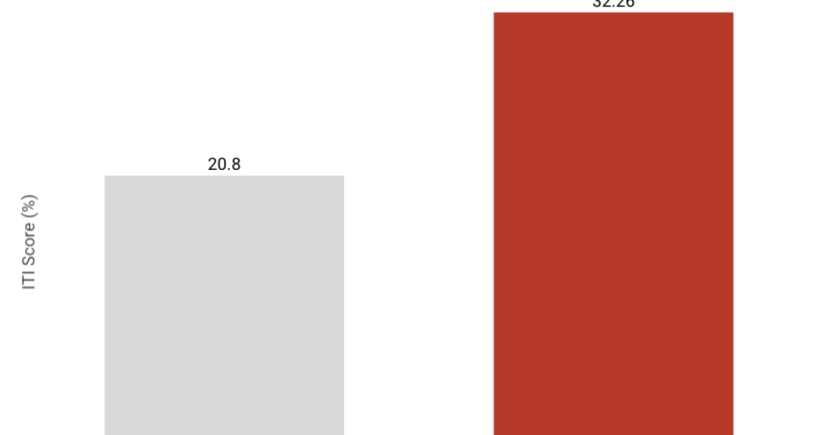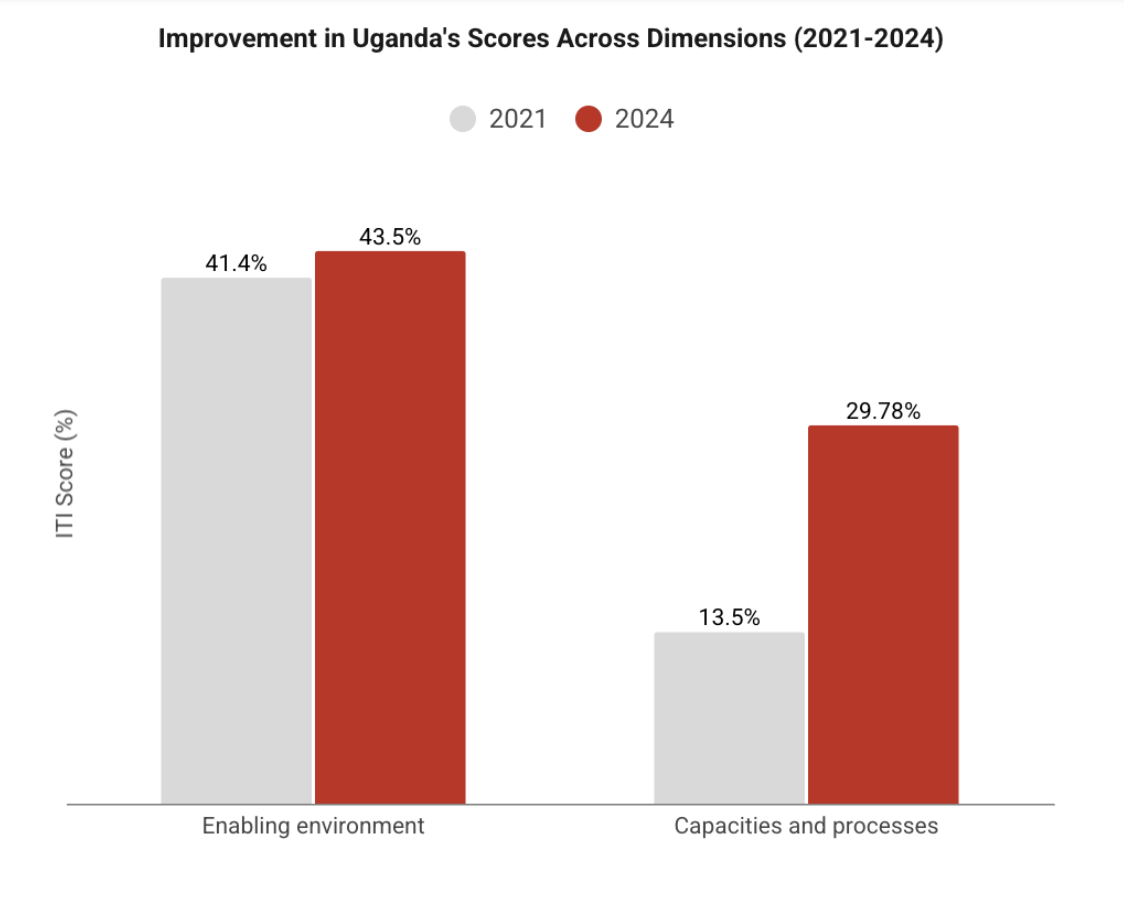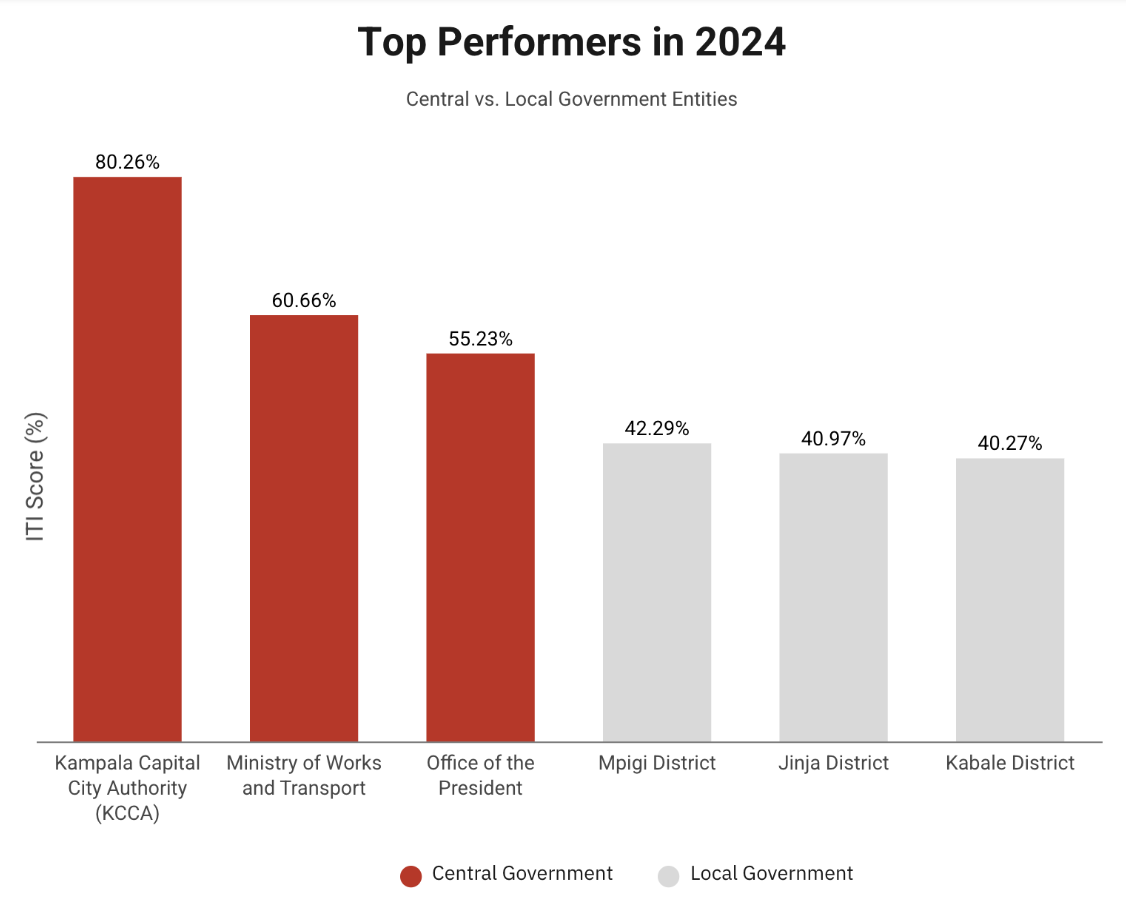2024 ITI Results Highlight Progress and Challenges
In 2024, CoST Uganda announced an 11% overall improvement in infrastructure transparency, as measured by its second Infrastructure Transparency Index (ITI). The assessment evaluated 30 government entities responsible for 58 projects across transport, health, education, water, and energy sectors. Minister of Works and Transport, Gen. Edward Katumba Wamala, underscored the government’s unwavering commitment to international transparency standards. Speaking with conviction, he stated,
“As we celebrate this win, I appeal to all government entities, oversight bodies, and non-state actors to engage deeply with these recommendations, hold us accountable, and join us in driving the transformational change our sector so urgently needs.”
The Ag. Engineer In Chief, Eng. Stephen K. Kitonsa read the statement on behalf the Minister. The statement highlighted the government’s commitment to comply with international standards for measuring the processes and systems for delivering public infrastructure projects, and the government’s readiness to respond to public concerns on infrastructure development using the data published through these reports.
11% improvement in the 2nd Index
In Uganda, the ITI plays a crucial role. It serves as an evidence-based tool to assess how well public entities manage infrastructure projects, encouraging continuous improvement. The ITI not only benchmarks transparency practices but also stimulates conversations and actions among stakeholders, leading to tangible changes—like improved drainage systems or enhanced data publication—that directly benefit communities.
The 2024 assessment included 10 entities from the 2021 pilot index and 20 new procuring entities, with the collaboration of the Permanent Secretaries, Heads of government departments and agencies, and the Chief Administrative Officers of ten sampled districts.
The index focuses on four critical areas of assessing infrastructure transparency levels: the enabling environment, capacities and processes for delivering public infrastructure projects, citizen participation, and information disclosure.
The results of the index highlight that Uganda’s national ITI score improved significantly, rising from 20.8% in 2021 to 32.26% in 2024, indicating strong progress in promoting infrastructure transparency.
This improvement suggests that results from the previous ITIs were acted upon. One such example in Uganda was where the ITI results informed decisions to improve the drainage system across the divisions by the Kampala Capital City Authority.
Performance per dimension
Overall, the data reveals improvements across all assessed dimensions from 2021 to 2024. While the enabling environment saw a modest increase from 41.4% to 43.5%, significant growth was observed in capacities and processes, more than doubling from 13.5% to 29.78% (a 120.6% increase and the largest percentage improvement). Citizen participation also showed substantial progress, rising from 13.8% to 33.65%, and data publication improved notably from 18.4% to 26.81%.
Recognizing performance
The top performing institution in central government entities was the Kampala Capital City Authority (KCCA) (80.26%), Ministry of Works and Transport (60.66%), and the Office of the President (55.23%).
On the other hand, the top performing in local governments was in Mpigi District (42.29%), Jinja District (40.97%), and Kabale District (40.27%).
The most improved performance was by Jinja District Local Government, which increased from 5.76% (2021) to 40.97% (2024) which represents a remarkable upgrade of 35.21%—and National Water and Sewerage Corporation (NWSC), which increased from 20.38% (2021) to 48.86% (2024) with a significant advance of 28.48%.
Central government entities, especially KCCA (80.26%), demonstrate significantly higher transparency scores than local governments, with all top performers exceeding 55%.
Notable improvements, particularly at the local government level, suggest effective capacity-building efforts and developments in central Government entities may also be in part linked to donor-funded projects with transparency requirements.
CoST Uganda recognizes that leadership commitment and organizational culture play crucial roles in transparency advancements. For example, the Office of the Prime Minister (OPM) has been very supportive and a key recipient of CoST reports.
“The OPM uses CoST reports to inform the general government performance reviews, monitoring of government and donor funded projects resulting from recommendations from CoST reports and other players, the OPM included government funded projects to be reviewed as part of this process. The reports are used to inform discussions on the development committee that approves and appraises public investments, the committee sits every month.” said the Monitoring and Evaluation Commissioner from the Office of the Prime Minister.
Looking ahead
Among other recommendations, CoST Uganda points out the necessity of developing detailed implementation guidelines for transparency policies and implementing a comprehensive transparency framework across project stages.
Furthermore, it suggests the Procurement Authority (PPDA) launches a capacity-building program and establishing a peer learning network, strengthening oversight bodies and introducing performance-based incentives and sanctions, and enhancing citizen engagement through user-friendly interfaces and public awareness campaigns.
CoST Uganda remains committed to promoting transparency and improving the management of public infrastructure. We encourage all entities to strive for continuous improvement and look forward to even greater progress in the next ITI assessment.
The second ITI, designed collaboratively based on international best practices and lessons learned, aims to provide stakeholders with high-quality information to promote transparency and enhance public infrastructure management. CoST Uganda urges stakeholders to disseminate the ITI results widely, facilitating follow-up on the implementation of recommendations.
The summary and comprehensive report is available on the Infrastructure Transparency Index website.


